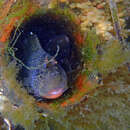en
names in breadcrumbs


Hypsoblennius gentilis és una espècie de peix de la família dels blènnids i de l'ordre dels perciformes.
Menja invertebrats bentònics i algues.[6]
És un peix de clima subtropical que viu fins als 25 m de fondària.[7][3]
Es troba des de Califòrnia (Estats Units) fins a la Península de Baixa Califòrnia (Mèxic) i el Golf de Califòrnia.[3][8][9][10]
Hypsoblennius gentilis és una espècie de peix de la família dels blènnids i de l'ordre dels perciformes.
Hypsoblennius gentilis, commonly known as the bay blenny, is a species of combtooth blenny found in the eastern-central Pacific Ocean. This species grows to a length of 15 centimetres (5.9 in) TL.[2]
Hypsoblennius gentilis, commonly known as the bay blenny, is a species of combtooth blenny found in the eastern-central Pacific Ocean. This species grows to a length of 15 centimetres (5.9 in) TL.
Hypsoblennius gentilis es una especie de pez de la familia Blenniidae en el orden de los Perciformes.
Los machos pueden llegar alcanzar los 15 cm de longitud total.[1][2]
Come invertebrados bentónicos y algas.
Es ovíparo.
Es un pez de mar y de clima subtropical que vive hasta los 25 m de profundidad.
Se encuentra desde California (Estados Unidos) hasta la Península de Baja California (México) y el Golfo de California.
Hypsoblennius gentilis es una especie de pez de la familia Blenniidae en el orden de los Perciformes.
Hypsoblennius gentilis Hypsoblennius generoko animalia da. Arrainen barruko Actinopterygii klasean sailkatzen da, Blenniidae familian.
Hypsoblennius gentilis Hypsoblennius generoko animalia da. Arrainen barruko Actinopterygii klasean sailkatzen da, Blenniidae familian.
Hypsoblennius gentilis is een straalvinnige vissensoort uit de familie van naakte slijmvissen (Blenniidae).[2] De wetenschappelijke naam van de soort is voor het eerst geldig gepubliceerd in 1854 door Girard.
De soort staat op de Rode Lijst van de IUCN als niet bedreigd, beoordelingsjaar 2007.[1]
Bronnen, noten en/of referenties